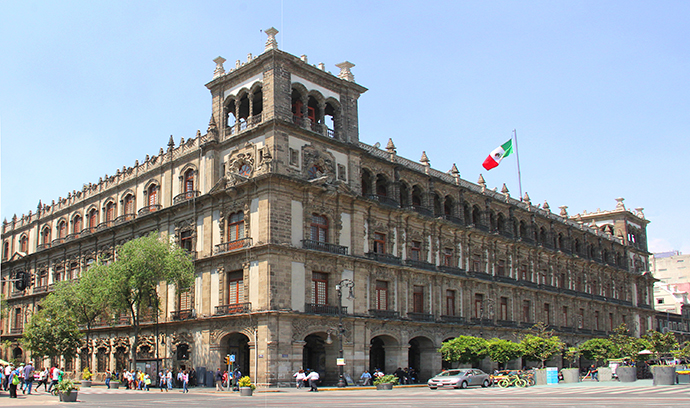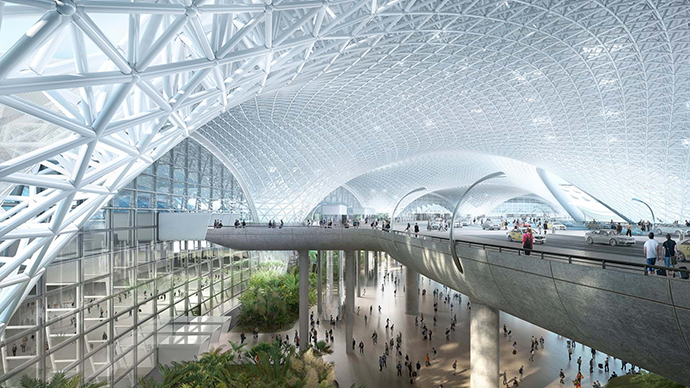From a centuries-old palace to Mexico City’s ambitious new airport, sustainable design and construction have taken hold in Mexico.
In January, when the U.S. Green Building Council (USGBC) released an annual survey of countries employing its environmentally sustainable LEED standard, Mexico appeared in the top 10 for the first time. This June, Mexico City will host the Council’s yearly Greenbuild International Conference, another sign of the country’s vault into the top ranks of the sustainability-conscious.
Why the surge of green building in Mexico?
“I think a lot of it has to do with the reputation that Mexico City has as probably one of the most contaminated cities in the world,” says Andres Galvis, regional director for Latin America for the Irvine, California-based Ware Malcomb, an international design firm with offices in Mexico. “That is a driver for foreign companies that come not just to Mexico City but to Mexico in general. They’re making a push to make the environment more friendly.”

USGBC’s Nicolette Mueller agrees that perceptions play a role, noting that “performance and transparency is really important for the institutional investors and financial backers for the real estate market.”
But, she says, there’s more to it than branding. Mueller, the Council’s director of global marketing development for Latin America, says Mexico is home to 622 LEED-certified professionals, more than twice as many as any other country in the region.
“If you meet with a developer and they say they’re interested in learning about LEED, the odds of getting someone who says ‘Yes, I can do that’ are going to be way higher in Mexico than anywhere in Latin America. That’s a unique advantage. In terms of commercial trends,” Mueller tells Site Selection, “there’s a lot of crossover between what happens in the U.S. and what happens in Mexico. So, a lot of those commercial trends are going to be the same. Mexico is a really booming market for sustainable construction.”
“Mexico is a really booming market for sustainable construction.”
USGBC reports that Mexico has 1,007 projects participating in LEED with 329 fully certified, representing 70 million gross sq. ft. (6.5 million gross sq. m.) of space. LEED can be found in Mexico from corporate offices to schools, hospitals, factories, restaurants and hotels. Monterrey’s new soccer stadium achieved LEED Silver status in 2016; a 7-Eleven on the University of Monterrey campus, the world’s only LEED-certified convenience store, generates renewable electricity through solar panels.
Leading the Way
Completed in 2006 at a reported cost of around $150 million, HSBC Tower in Mexico City’s financial district is widely considered to have been at the forefront of green construction in Mexico. The 34-level skyscraper was the first building in Latin America to achieve LEED Gold certification.
Energy efficiency, potable water reduction, wastewater technologies and environmentally-friendly recycled furniture all were integrated into the building’s design. An open office plan brings daylight into employees’ workspaces. A 4,000-sq.-ft. (372-sq.-m.) green roof reduces water runoff, reduces urban heat and serves as a casual meeting place. The tower achieved LEED Platinum status in 2012.
Other significant LEED projects in Mexico include:
Torre BBVA Bancomer, Mexico City: The 51-story, 1.9-million-sq.-ft. (183,000-sq.-m.) tower achieved LEED Platinum certification in the Building Design and Construction category in March, through effective use of resources such as water and energy and by virtue of quality-of-life features built in for employees. The building serves as headquarters for the bank’s Latin America operations.
Antiguo Palacio del Ayuntamiento, Mexico City: Built under Hernán Cortés in the 1500s, the massive edifice known as the Old Palace of the City Council obtained LEED Platinum certification in March, becoming the oldest building in the world to achieve the designation. The palace underwent a years-long renovation that included the introduction of LED lighting, a rainwater collection system, photovoltaic cells, air injection systems and a recycling policy for waste.
Universidad del Arte, Puebla: Through the utilization of native vegetation and a water filtration system, “UNARTE” harvests, treats and reuses all of its rainwater. The building’s design promotes natural lighting and ventilation. Built on a former parking lot, it was conceived as a way to help restore the area’s original topography.
Beiersdorf Production Center, Silao: The German-owned cosmetics plant was the first industrial building in Latin America to achieve LEED Platinum status. Its features include a 400-kilowatt photovoltaic system that helps reduce energy costs by 62-percent, according to USGBC. During construction, 95 percent of construction waste was diverted from landfills and 33 percent of building materials came from recyclables.
Mexico City Airport: Construction of the capital’s new airport, expected to be completed in 2020, includes a $22-million solar plant, part of an effort to make the facility fully powered by renewables. Officials say the sprawling complex will use 30 percent less water and 40 percent less energy than the existing Mexico City International Airport. The airport, designed by London-based Foster + Partners, is aiming for a LEED Platinum certification, which would arguably make it the most environmentally friendly airport in the world.
Editor’s Note: Mexico ranked No. 10 in last year’s Site Selection Sustainability Rankings. The 2018 edition of those rankings will appear in the July 2018 issue.

